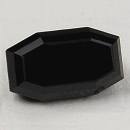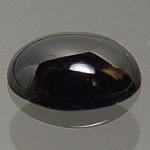|
ClassicGems.net |
|
|
 |
| Neptunite |
|
|
Discovered in 1893; IMA status: Valid (pre-IMA; Grandfathered) | |||
|
|
|
Chemistry |
|
|
| |
|
KNa2Li(Fe2+,Mn2+)2Ti2Si8O24 |
|
|
|
Potassium Sodium Lithium Iron Manganese Titanium Silicate |
|
Molecular Weight: |
907.69 gm |
|
Composition: |
Potassium |
4.31 % |
K |
5.19 % |
K2O |
|
|
Sodium |
5.07 % |
Na |
6.83 % |
Na2O |
|
|
Lithium |
0.76 % |
Li |
1.65 % |
Li2O |
|
|
Titanium |
10.55 % |
Ti |
17.60 % |
TiO2 |
|
|
Manganese |
3.03 % |
Mn |
3.91 % |
MnO |
|
|
Iron |
9.23 % |
Fe |
11.87 % |
FeO |
|
|
Silicon |
24.75 % |
Si |
52.96 % |
SiO2 |
|
|
Oxygen |
42.30 % |
O |
|
|
|
|
|
100.00 % |
|
100.00 % |
= TOTAL OXIDE |
|
|
|
||||
|
Classification |
|
|
| |
|
Silicates | |
|
8/F.37-10 | |
|
|
9 : SILICATES (Germanates)
|
|
Related to: |
Neptunite Group. Isostructural with Manganoneptunite. Manganoneptunite-Neptunite Series. |
|
Members of Group: |
Neptunite Group: Magnesioneptunite, Manganoneptunite, Neptunite |
|
Varieties: |
None |
|
Synonyms: |
Carlosite, Ferroneptunite, ICSD 71360, PDF 43-677 |
|
|
|
|
Crystal Data |
|
|
|
|
|
As prismatic crystals, to 7.5 cm, with {110} prominent, typically with square cross sections, may be curved or twisted. |
|
|
Interpenetrant on {301}. |
|
|
|
|
|
Physical Properties |
|
|
|
|
|
Perfect on {110} |
|
|
Conchoidal |
|
|
Brittle |
|
|
5.0 - 6.0 |
|
|
3.19 - 3.23 (g/cm3) |
|
|
None |
|
|
Not Radioactive |
|
|
Other: | |
|
|
|
|
Optical Properties |
|
|
|
|
|
Black; deep blood red to red-brown in thin fragments |
|
|
Opaque to nearly opaque |
|
|
Vitreoius |
|
|
1.690 - 1.736 Biaxial ( + ) |
|
|
0.029 - 0.045 |
|
|
r < v; strong to extreme |
|
|
Visible; X = pale yellow; Y = yellow-orange; Z = red-orange to red-brown |
|
|
|
|
|
Occurances |
|
|
|
|
|
Geological Setting: |
In natrolite veins cutting a glaucophane schist inclusion in a serpentinite body (San Benito County, California, USA). |
|
Common Associations: |
Eudialyte, Arfvedsonite, Aegirine (Narssârssuk, Greenland); Natrolite, Benitoite, Joaquinite-(Ce) (San Benito County, California, USA); Nordite-(La), Lomonosovite, Sodalite, Ussingite (Kola Peninsula, Russia). |
|
Common Impurities: |
Ca |
|
Type Locality: |
Narsaarsuk pegmatite (Narssârssuk pegmatite), Narsaarsuk Plateau, Igaliku (Igaliko), Narsaq, Kujalleq, Greenland |
|
Year Discovered: |
1893 |
|
View mineral photos: | |
|
|
|
|
Unusual Gem Categories |
|
|
|
|
|
| |
|
|
|
|
More Information |
|
|
|
|
|
| |
|
|
|
|
Neptunite is a rare lithium titanium silicate mineral that is popular as mineral specimens but rarely available as faceted gems. Neptunite forms shiney black, elongated, prismatic crystals which are usually square in cross section with pointed terminations. It is opaque and black except in very small fragments. Thin fragments may be dark, blood red to dark, brownish red. Neptunite is usually available only as beautiful mineral specimens set in a matrix of pure white Natrolite along with blue Benitoite crystals and rarely with orangish brown Jaoquinite-(Ce) crystals. Although there are several locations throughout the world to find Neptunite crystals, the most well known source of Neptunite is at the now closed Benitoite Gem Mine, San Benito County, California, USA. Neptunite is one of the unusual minerals that exhibit the piezoelectric effect. Piezoelectricity is the ability of some mineral crystals to generate a voltage in response to applied mechanical stress such as an external pressure. Piezoelectricity was discovered in 1880 by French physicists, brothers Jacques and Pierre Curie. Neptunite was named in 1893 by Swedish mineralogist Gustav Flink (1848-1931) for Neptune, the Roman god of the sea. This name was given because of Neptunite's close association at its type locality at Narssârssuk, Greenland with the mineral Aegirine, named for Ægir, god of the sea and king of all sea creatures in Norse mythology. Aegirine was named in 1834 by Norwegian priest and mineralogist Hans Morten Thrane Esmark (1801-1882). Neptunite distribution: from Narssârssuk, Iglunguak, and the Ilímaussaq intrusion, Greenland. In the Inagli massif, 30 km west of Aldan, Yakutia, and in the Khibiny and Lovozero massifs, Kola Peninsula, Russia. From the Khan-Bogdinskii granitic massif, Gobi, Mongolia. In the Dara-i-Pioz massif, Alai Range, Tien Shan, Tajikistan. From Barnavave, near Carlingford, County Louth, Ireland. At Mont Saint-Hilaire, Quebec, and Seal Lake, Labrador, Newfoundland, Canada. In the USA, splendid crystals from the Benitoite Gem mine and Mina Numero Uno, San Benito County, California, and at Point of Rocks, Colfax County, New Mexico. From near Woodsreef, New South Wales, Australia. |
|
|
Neptunite gems for sale:
|
|||||||||||||||||||||||||||
